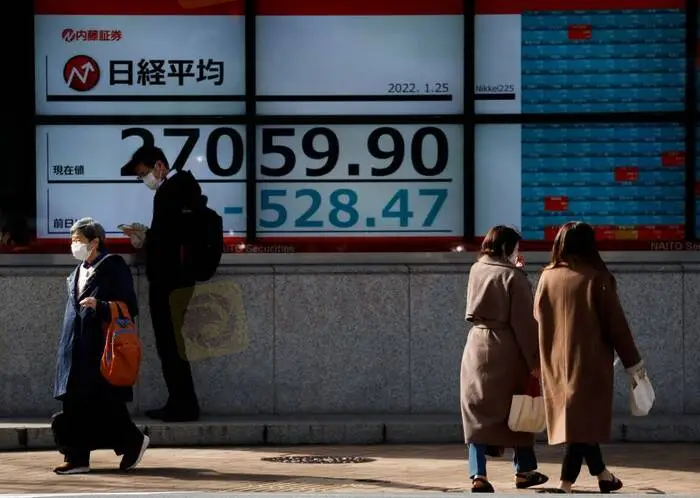简体中文
繁體中文
English
Pусский
日本語
ภาษาไทย
Tiếng Việt
Bahasa Indonesia
Español
हिन्दी
Filippiiniläinen
Français
Deutsch
Português
Türkçe
한국어
العربية
U.S. yields rise, Asian shares slump as Powell warns on inflation
Abstract:Asian shares fell to their lowest in more than 14 months, short-term U.S. yields rose to 23-month highs and the dollar strengthened on Thursday after the Federal Reserves chairman signaled plans to steadily tighten policy.

At the same time, rising investor concerns over political tensions between Russia and Ukraine exacerbated worries over tight energy market supply, keeping oil prices elevated at multi-year highs despite some profit-taking.
In its latest policy update on Wednesday, the Fed indicated it is likely to raise U.S. interest rates in March, as has been widely expected, and reaffirmed plans to end its bond purchases that month before launching a significant reduction in its asset holdings.
But in the follow-up press conference, Powell warned that inflation remains above the Feds long-run goal and supply chain issues may be more persistent than previously thought.
“There was a marked shift in terms of a relatively dovish statement and then a relatively hawkish press conference,” said David Chao, global market strategist, Asia Pacific (ex-Japan) at Invesco.
“Powell (is) not committing to the size or the frequency of rate hikes and also the timing of the balance sheet reduction. I think that buys him a bit of wiggle room as to how quickly and with what velocity he wants to normalise monetary policy in the U.S. … it‘s very data dependent and so we’re certainly watching other economic data thats going to be released especially inflation data, inflation expectations data, which I think could trigger more aggressive monetary policy tightening.”
Fed funds futures showed traders pricing in as many as five hikes by December, after previously fully pricing for four increases. [FEDWATCH]
Concerns that the Fed will increasingly prioritise fighting inflation walloped share markets. MSCIs broad gauge of regional markets outside Japan fell more than 2% on Thursday to its lowest level since Nov. 5, 2020.
Hong Kong‘s Hang Seng index and Australian shares fell more than 2% and Chinese blue-chips dropped to their lowest level since Sept. 30, 2020 as Refinitiv flows data pointed to heavy selling by foreign investors through the country’s Stock Connect scheme.
In Tokyo, the Nikkei fell more than 2.5%, touching its lowest point since Nov. 26, 2020.
The drop echoed a sharp reversal in U.S. shares overnight. The S&P 500 closed 0.14% lower following Powells comments after earlier rising more than 2%, and the Nasdaq Composite finished barely higher, erasing a rise of more than 3.4%. [.N]
The policy-sensitive U.S. 2-year yield jumped amid expectations of Fed tightening, rising to a top of 1.1920% in morning trade in Asia, a level last reached in February 2020. The benchmark 10-year yield also ticked up from Wednesdays close, rising to 1.8566% from 1.846%.
The dollar rose on the back of higher yields, lifting the U.S. dollar index, which measures the greenback against major peers, to 96.604, near five-week highs..
The yen was flat at 114.63, while the euro weakened 0.1% to $1.1225.
“The interesting play seems to be that yield differentials matter again, so we‘ve got a decent set-up on dollar-yen. If you look at the yield differential between the 2-year on the U.S. and the Japanese, it’s just shot up,” said Matt Simpson, senior market analyst at City Index in Sydney.
The spread between the U.S. and Japanese 2-year yield widened to 124.22 basis points on Thursday, its highest since late February 2020.
In commodities markets, oil prices eased but remained elevated near $90 per barrel, a level last seen in October 2014, on festering tensions between Russia and Ukraine.
The United States said on Wednesday it had set out a diplomatic path to address sweeping Russian demands in eastern Europe, as Moscow held security talks with Western countries and intensified its military build-up near Ukraine with new drills.
On Thursday, global benchmark Brent crude fell 0.64% on profit taking to $89.38 per barrel. U.S. West Texas Intermediate crude was down 0.6% at $86.83 per barrel.
U.S. officials say they are in talks with major energy-producing countries and companies worldwide over a potential diversion of supplies to Europe if Russia invades Ukraine, although the White House said it faces challenges finding alternative sources of energy supplies.
Spot gold slipped 0.12% to $1,815.88 an ounce.
“When you see gold falling with stocks it‘s usually a signal that things aren’t so well, but you can really tie everything back to the Fed raising rates, the dollar screaming higher with the yields, everything else is going the opposite way,” said Simpson at City Index.

Disclaimer:
The views in this article only represent the author's personal views, and do not constitute investment advice on this platform. This platform does not guarantee the accuracy, completeness and timeliness of the information in the article, and will not be liable for any loss caused by the use of or reliance on the information in the article.
Read more

Top Tips to Avoid Forex Margin Calls and Protect Your Capital
While technical indicators or chart patterns often capture the attention of forex traders, especially new ones, aspects such as margin requirements, equity, used margin, free margin, and margin levels are often overlooked. So, if you have received a margin call from your forex broker and are wondering how to deal with it, you probably do not know the concept of a forex margin call - what triggers it and how to avoid it. Being unaware of this concept can make you lose your hard-earned capital. In this article, we will provide you with all the information you need to know. Keep reading!

Voices of the Golden Insight Award Jury | Peter Karsten, CEO STARTRADER
WikiFX Golden Insight Award uniting industry forces to build a safe and healthy forex ecosystem, driving industry innovation and sustainable development, launches a new feature series — “Voices of the Golden Insight Awards Jury.” Through in-depth conversations with distinguished judges, this series explores the evolving landscape of the forex industry and the shared mission to promote innovation, ethics, and sustainability.

A Guide to Determining the Optimum Forex Leverage
Want to gain a wider forex market position control by investing a minimal amount? Consider using leverage in forex. It implies using borrowed funds to raise your trading position more than your cash balance can let you do it. Forex traders usually employ leverage to churn out profits from relatively small currency pair price changes. However, there is a double-edged sword with leverage since it can multiply profits as well as losses. Therefore, using leverage in the right amount is key for traders. Forex market leverage can be 50:1 to 100:1 or more, which remains significantly greater than the 2: leverage usually offered in equities and 15:1 leverage in futures.

ECN Forex Trading Account Explained: Unlocking Key Details for a Seamless Trading Experience
Seeking forex trading without any third-party involvement? You have an electronic communication network (ECN) by which you can trade through a computerized system that matches buy and sell orders automatically, eliminating the need for a third party. ECN forex trading especially helps investors across different geographies seeking a secure transaction without a third party. With ECN, investors receive privacy, the luxury of automated investing, and the approach to trade beyond normal market hours.
WikiFX Broker
Latest News
Is Nash Markets Regulated or Risk? Truth About Nash Markets’ License & Withdrawal Issues
Webull Widens Crypto Futures with Coinbase Derivatives
Latest FCA Daily Alerts and Consumer Warnings for 2025
CySEC Blocks Certification Access to Combat Advisor Impersonation
Angel one 2025 Review & Complaints
Exclusive Markets Under the Scanner: Traders Report High Swap Charges, Deposit Discrepancies & More
Annual Sales Of New Vehicles Expected To Hit Only 15.7 Million Units: Cox
Saxo Bank Japan Expands European Stock Portfolio with UBS, Ferrari, and Other Major Names
Amillex Broker Affiliate Program: A Complete Guide to Earning with Referrals
New SC Rules Take Effect in November 2025: What’s Next for Finfluencers?
Currency Calculator



